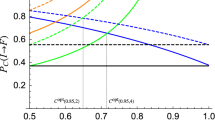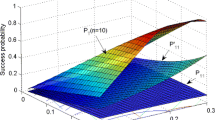Abstract
Quantum catalytic transformations play important roles in the transformation of quantum entangled states under local operations and classical communications (LOCC). The key problems in catalytic transformations are the existence and the bounds on the catalytic states. We present the necessary conditions of catalytic states based on a set of points given by the Schmidt coefficients of the entangled source and target states. The lower bounds on the dimensions of the catalytic states are also investigated. Moreover, we give a detailed protocol of quantum mixed state transformation under entanglement-assisted LOCC.

Similar content being viewed by others
References
Wakakuwa, E., Soeda, A., Murao, M.: Complexity of causal order structure in distributed quantum information processing: more rounds of classical communication reduce entanglement cost. Phys. Rev. Lett. 122, 190502 (2019)
Chitambar, E., Gour, G.: Quantum resource theories. Rev. Mod. Phys. 91, 025001 (2019)
Berta, M., Brandão, F.G.S.L., Majenz, C., Wilde, M.M.: Deconstruction and conditional erasure of quantum correlations. Phys. Rev. A 98, 042320 (2018)
Berta, M., Majenz, C.: Disentanglement cost of quantum states. Phys. Rev. Lett. 121, 190503 (2018)
Horodecki, R., Horodecki, P., Horodecki, M., Horodecki, K.: Quantum entanglement. Rev. Mod. Phys. 81, 865–942 (2009)
Bennett, C.H., Brassard, G.: Quantum cryptography: public key distribution and coin tossing. In: Proceedings of the IEEE International Conference on Computers, Systems and Signal Processing IEEE Computer Society, pp. 175–179 (1984)
Bandyopadhyay, S., Ghosh, S., Roychowdhury, V.: Non-full-rank bound entangled states satisfying the range criterion. Phys. Rev. A 71, 012316 (2005)
Bennett, C.H., Brassard, G., Crépeau, C., Jozsa, R., Peres, A., Wootters, W.K.: Teleporting an unknown quantum state via dual classical and Einstein–Podolsky–Rosen channels. Phys. Rev. Lett. 70, 1895–1899 (1993)
Raussendorf, R., Briegel, H.J.: A one-way quantum computer. Phys. Rev. Lett. 86, 5188–5191 (2001)
Deutsch, D., Penrose, R.: Quantum theory, the Church–Turing principle and the universal quantum computer. Proc. R. Soc. Lond. A. Math. Phys. Sci. 400(1818), 97–117 (1985)
Nielsen, M.A.: Conditions for a class of entanglement transformations. Phys. Rev. Lett. 83, 436–439 (1999)
Marshall, A.W., Olkin, I., Arnold, B.C.: Inequalities: Theory of Majorization and Its Applications. Springer, New York (1979)
Alberti, P., Uhlmann, A.: Stochasticity and Partial Order: Doubly Stochastic Maps and Unitary Mixing. Mathematics and its Applications, vol. 9. VEB Deutscher Verlag der Wissenschaften. D. Reidel Publishing Company, Berlin (1982)
Jonathan, D., Plenio, M.B.: Entanglement-assisted local manipulation of pure quantum states. Phys. Rev. Lett. 83, 3566–3569 (1999)
Turgut, S.: Catalytic transformations for bipartite pure states. J. Phys. A Math. Theor. 40(40), 12185–12212 (2007)
Sun, X., Duan, R., Ying, M.: The existence of quantum entanglement catalysts. IEEE Trans. Inf. Theory 51(1), 75–80 (2005)
Bandyopadhyay, S., Roychowdhury, V.: Efficient entanglement-assisted transformation for bipartite pure states. Phys. Rev. A 65, 042306 (2002)
Sanders, Y.R., Gour, G.: Necessary conditions for entanglement catalysts. Phys. Rev. A 79, 054302 (2009)
Daftuar, S., Klimesh, M.: Mathematical structure of entanglement catalysis. Phys. Rev. A 64, 042314 (2001)
Duan, R., Feng, Y., Ying, M.: When catalysis is useful for probabilistic entanglement transformation. Phys. Rev. A 69, 062310 (2004)
Dam, W.V., Hayden, P.: Universal entanglement transformations without communication. Phys. Rev. A 67, 060302 (2003)
Eisert, J., Wilkens, M.: Catalysis of entanglement manipulation for mixed states. Phys. Rev. Lett. 85, 437 (2000)
Grabowecky, M., Gour, G.: Bounds on entanglement catalysts. Phys. Rev. A 99, 052348 (2019)
Guifré, V.: Entanglement of pure states for a single copy. Phys. Rev. Lett. 83, 1046–1049 (1999)
Horodecki, M., Oppenheim, J., Sparaciari, C.: Extremal distributions under approximate majorization. J. Phys. A Math. Theor. 51, 305301 (2018)
Acknowledgements
YMG and SMF acknowledge the support from NSF of China under Grant No. 12075159, Beijing Natural Science Foundation (Z190005), Academy for Multidisciplinary Studies, Capital Normal University, Shenzhen Institute for Quantum Science and Engineering, Southern University of Science and Technology (No. SIQSE202001), and the Academician Innovation Platform of Hainan Province. YS, MYH, LJZ and LC were supported by the NNSF of China (Grant Nos. 11871089 and 11947241) and the Fundamental Research Funds for the Central Universities (Grant Nos. KG12080401 and ZG216S1902).
Author information
Authors and Affiliations
Corresponding author
Additional information
Publisher's Note
Springer Nature remains neutral with regard to jurisdictional claims in published maps and institutional affiliations.
Appendix
Appendix
1.1 A. Proof of Proposition 1
Proof
If the conclusion is not true, one would have \(q_1r_{s+1}\le q_lr_s\), \(q_{l+1}r_s\le q_dr_{s-1}\) or \(q_1r_{s+1}\le q_dr_{s-1}\), which imply that the largest \(d(s-1)+l\) elements of \({\mathbf {q}} \otimes {\mathbf {r}}\) are \(q_1r_1,\ldots ,q_dr_1\), \(q_1r_2,\ldots ,q_dr_2\), \(\ldots \), \(q_1r_s,\ldots ,q_lr_s\). The summation of these largest \(d(s-1)+l\) elements of \({\mathbf {q}} \otimes {\mathbf {r}}\) gives
Meanwhile, the largest \(d(s-1)+l\) elements of \({\mathbf {p}} \otimes {\mathbf {r}}\) are not less than the sum of the terms \(p_1r_1,\ldots ,p_dr_1\), \(p_1r_2,\ldots ,p_dr_2\), \(\ldots \), \(p_1r_s,\ldots ,p_lr_s\),
On the other hand, since \(l\in {\mathcal {L}}\) and \(\sum _{j= 1}^lp_j >\sum _{j= 1}^lq_j \), we have
for any \(s=2,3,\ldots ,k-1\), which contradicts the assumption that \({\mathbf {p}} \otimes {\mathbf {r}} \prec {\mathbf {q}} \otimes {\mathbf {r}}\).
Next we prove the first inequality in (6). Since \(l\in {\mathcal {D}}_1\), we have \(p_1+\cdots +p_l>q_1+\cdots +q_l\) and \(p_1+\cdots +p_{l+1}\le q_1+\cdots +q_{l+1}\), which give rise to \(p_{l+1}<q_{l+1}\). Taking into account \(p_d>q_d\), we have \(\frac{p_d}{p_{l+1}}>\frac{q_d}{q_{l+1}}\) as \({\mathbf {p}}\) and \({\mathbf {q}}\) are solvable incomparable.
We use proof by contradiction. If \(\frac{q_d}{q_{l+1}}\ge \frac{r_k}{r_{k-1}}\), i.e., \(q_dr_{k-1}\ge q_{l+1}r_k\), then the smallest \(d-l\) elements of \({\mathbf {q}} \otimes {\mathbf {r}}\) are \(q_{l+1}r_k,q_{l+2}r_k,\ldots ,q_dr_k\). Moreover, the sum of the smallest \(d-l\) elements of \({\mathbf {p}} \otimes {\mathbf {r}}\) is not larger than the sum of \(p_{l+1}r_k,p_{l+2}r_k,\ldots ,p_dr_k\). Because of \(l\in {\mathcal {L}}\), we get \(p_{l+1}+\cdots +p_d<q_{l+1}+\cdots +q_d\). Therefore, we have the following relation,
which contradicts the assumption that \({\mathbf {p}} \otimes {\mathbf {r}} \prec {\mathbf {q}} \otimes {\mathbf {r}}\), and proves the first inequality in (6).
Concerning the second inequality in (6), we use again the proof by contradiction. If \(\frac{q_1}{q_l}\le \frac{r_1}{r_2}\), the largest l elements of \({\mathbf {q}} \otimes {\mathbf {r}}\) are \(q_1r_1,q_2r_1,\ldots ,q_lr_1\). Since the sum of the largest l elements of \({\mathbf {p}} \otimes {\mathbf {r}}\) is not less than the sum of \(p_1r_1,p_2r_1,\ldots ,p_lr_1\) for \(l\in {\mathcal {L}}\), we have \(p_1+\cdots +p_l>q_1+\cdots +q_l\). Then we have the relation,
which contradicts the assumption that \({\mathbf {p}} \otimes {\mathbf {r}} \prec {\mathbf {q}} \otimes {\mathbf {r}}\) and proves the second inequality in (6). \(\square \)
1.2 B. A remark on the relationship between Proposition 1 and Theorem 1 in [23]
In the proof of Theorem 1 in [23], it is mentioned that “\(q_{m} r_{v^{\prime }} \geqslant q_{1} r_{v^{\prime }+1}\) implies that the first \(\left( v^{\prime }-1\right) d+m\) elements of \(({\mathbf {q}} \otimes {\mathbf {r}})^{\downarrow }\) consist of \(q_{x} r_{y}\), \(\forall x \in \{1,2, \ldots , d\}\) and \(\forall y \in \left\{ 1,2, \ldots , v^{\prime }-1\right\} \), along with \(q_{x^{\prime }} r_{v^{\prime }}\) \(\forall x^{\prime } \in \{1,2, \ldots , m\}\).” Generally this could be not true because some elements of \(q_{x} r_{y}\), \(x \in \{1,2, \ldots , d\}\), \(y \in \left\{ 1,2, \ldots , v^{\prime }-1\right\} \), along with \(q_{x^{\prime }} r_{v^{\prime }}\) \(\forall x^{\prime } \in \{1,2, \ldots , m\}\) might be less than some elements of \(q_{x^{\prime }} r_{v^{\prime }}\), \(x^{\prime } \in \{1,2, \ldots , d\}\), \(y^{\prime } \in \{ v^{\prime }+1, \ldots , k\}\), along with \(q_{x^{\prime }} r_{v^{\prime }}\) \(\forall x^{\prime } \in \{m+1, \ldots , d\}\), when \( q_{d} r_{v^{\prime }-1} < q_{m+1} r_{v^{\prime }}\) or \( q_{d} r_{v^{\prime }-1} < q_{1} r_{v^{\prime }+1}\). This implies that the first \(\left( v^{\prime }-1\right) d+m\) elements of \(({\mathbf {q}} \otimes {\mathbf {r}})^{\downarrow }\) do not consist of \(q_{x} r_{y}\), \(\forall x \in \{1,2, \ldots , d\}\) and \(\forall y \in \left\{ 1,2, \ldots , v^{\prime }-1\right\} \), along with \(q_{x^{\prime }} r_{v^{\prime }}\) \(\forall x^{\prime } \in \{1,2, \ldots , m\}\).
From Proposition 1, we have that the first \(\left( s-1\right) d+l\) elements of \(({\mathbf {q}} \otimes {\mathbf {r}})^{\downarrow }\) consist of \(q_{x} r_{y}\), \(\forall x \in \{1,2, \ldots , d\}\) and \(\forall y \in \left\{ 1,2, \ldots , s-1\right\} \), along with \(q_{x^{\prime }} r_{s}\) \(\forall x^{\prime } \in \{1,2, \ldots , l\}\) when \(q_{l} r_{s} \geqslant q_{1} r_{s+1}\), \(q_{d} r_{s-1} \geqslant q_{l+1} r_{s}\) and \(q_{d} r_{s-1} \geqslant q_{1} r_{s+1}\), which is true for \(\forall l \in \mathcal {L}\). Hence, Proposition 1 fills such loopholes in Theorem 1 in [23] and also gives finer characterizations of \({\mathbf {r}}\) by increasing the number of constraints on \({\mathbf {r}}\).
1.3 C. Proof of corollary 2
Proof
By the definition of \(M_{\mathcal{L}}\), we have:
This implies that \(p_{M_{\mathcal{L}}+1}<q_{M_{\mathcal{L}}+1}\). Combining with \(p_d\geqslant q_d\), we get
If \(\frac{q_d}{q_{M_{\mathcal{L}}+1}}\geqslant \frac{r_k}{r_{k-1}}\), we have the following partial order the vector \({\mathbf {q}} \otimes {\mathbf {r}}\),
For \(\frac{p_d}{p_{M_{\mathcal{L}}+1}}>\frac{q_d}{q_{M_{\mathcal{L}}+1}}\), we have the following partial order the vector \({\mathbf {p}} \otimes {\mathbf {r}}\),
Combining (12) and (13), we have that the last \(d-M_{\mathcal{L}}\) elements of \(( {\mathbf {p}} \otimes {\mathbf {r}} ) ^ { \downarrow }\) and \(( {\mathbf {q}} \otimes {\mathbf {r}} ) ^ { \downarrow }\) are \(p_dr_k\), \(p_{d-1}r_k\), \(\dots \), \(p_{M_{\mathcal{L}}+1}r_k\) and \(q_dr_k\), \(q_{d-1}r_k\), \(\dots \), \(q_{M_{\mathcal{L}}+1}r_k\), respectively. Therefore, we have
which implies that
and contradicts the assumption that \({\mathbf {p}} \otimes {\mathbf {r}} \prec {\mathbf {q}} \otimes {\mathbf {r}}\). \(\square \)
Rights and permissions
About this article
Cite this article
Guo, YM., Shen, Y., Zhao, LJ. et al. Necessary conditions on effective quantum entanglement catalysts. Quantum Inf Process 20, 356 (2021). https://doi.org/10.1007/s11128-021-03293-9
Received:
Accepted:
Published:
DOI: https://doi.org/10.1007/s11128-021-03293-9




